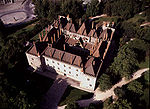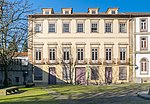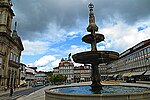Oliveira do Castelo
All uncategorized pagesUncategorized from February 2024

Oliveira do Castelo is a Portuguese village and extinct freguesia in the municipality of Guimarães, with an area of 0.69 km2 and 3265 inhabitants (2011). Its population density was of 4,731.9 inhabitants/km2. It was the seat of a freguesia that was abolished in 2013, as part of a national administrative reform, to form a new parish, together with São Paio and São Sebastião, called Oliveira, São Paio e São Sebastião, with its seat at Alameda de São Dâmaso in Guimarães.
Excerpt from the Wikipedia article Oliveira do Castelo (License: CC BY-SA 3.0, Authors, Images).Oliveira do Castelo
Rua Doutor Joaquim Meira, Guimarães
Geographical coordinates (GPS) Address Nearby Places Show on map
Geographical coordinates (GPS)
| Latitude | Longitude |
|---|---|
| N 41.450277777778 ° | E -8.2880555555556 ° |
Address
Rua Doutor Joaquim Meira
4800-432 Guimarães
Portugal
Open on Google Maps











